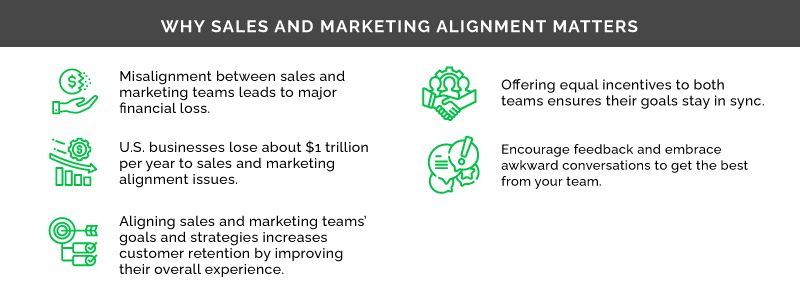How Sales and Marketing Alignment Affects Your Bottom Line

When your sales and marketing teams are working as one unit, your revenue possibilities skyrocket. Here’s how to achieve sales and marketing alignment.

Have you ever tried to take advantage of a great offer that seems targeted to your specific issue only to find that the sales rep knew nothing about it? If you answered “yes,” you’re unfortunately a victim of sales and marketing misalignment. What makes matters worse is hanging up without the offer and then still getting bombarded with calls, emails, and messages about other offerings – even after requesting removal from their lists.
The result is often a deep resentment for a company that you would have done business with in the past. Situations like this are common. Mismanaged sales and marketing alignments continually derail buying experiences year after year. Sales and marketing teams lose approximately $1 trillion per year in the U.S. because of poor coordination. There’s no way around it, misalignment is financially detrimental.
Getting marketing and sales on the same page improves customer experience and expands retention. It’s an effective strategy that works in every industry, so let’s go over what sales and marketing alignment means and how your teams can put it to work for you.
What is sales and marketing alignment?
Sales and marketing alignment is exactly what it sounds like. It means positioning your sales and marketing teams’ individual strategies to complement each other. Both teams have the same goal – to make money – but it’s easier to achieve that goal when they work together.
The problem is that it isn’t easy to get these two departments on the same page, regardless of their shared goal. The biggest reason for this is that sales and marketing departments consult different sets of data to make their decisions. Here’s what to know:
- Marketers use data management platform (DMP) systems like Oracle or Adobe to create and purchase massive lists of names.
- Victory for marketers means reaching a certain hit rate and augmenting for cost per lead (CPL).
- Sales professionals are devoted to using customer relationship management (CRM) systems.
- Victory for sales teams means a closed deal and a strong, open-ended business association.
These two teams also look at their potential customers in different ways and typically work alongside each other instead of in unison. This causes even wider misalignment. When sales and marketing are aware of each other’s strategies and work with the same information, they are in alignment.
Here are 5 ways to make this happen:
1. Ensure incentives are aligned
Aligning any two teams means aligning their goals, too. A marketing team incentivized to bring in loads of leads – no matter the quality – will provide a sales team with a plethora of low-quality leads, for example. Instead, incentivize both teams to reach the same goal based on the company’s key performance indicators (KPIs). KPIs are a metric used to measure a business's progress toward an established goal. Have both teams develop KPIs based on revenue instead of individual tasks. This will help them collaborate more efficiently.
2. Embrace feedback and awkward conversations
Friction is often necessary for growth. No two teams are always on the same page at all times. The fastest way to lose your competitive edge in business is to become complacent with current strategies and let things ride. Another way is to breed a work environment that houses fear or is so brimming with office politics that employees are reluctant to speak up. Instead, encourage an atmosphere of openness and acceptance where your employees are eager to share their ideas and look forward to improving the company they work for. Then, watch as profits soar.
3. Establish solid sales enablement strategies
Sales enablement involves teaching your sales staff all the ins and outs of what you sell, how to sell, and what's most important about your company. In essence, sales enablement is providing your team with the tools to close the deals. It often requires its own team of professionals to make it as effective as possible.
The enablement team behaves as an impartial intermediary between sales and marketing. It ensures salespeople have the proper training and guidance to use company resources to the very best possible outcome. Investing in an enablement team means you’re establishing a dependable conduit of information between company organizations. It also means you’re allowing salespeople and marketers to focus on using their talents to your advantage.
4. Incorporate smarketing
“Smarketing” happens when you have sales and marketing teams that work so closely together that they could be considered one team. Their goals and strategies are unified to do one thing: increase revenue by bringing in qualified sales. Introducing this concept to your teams can give it the credentials they need to not only take it seriously but also to recognize its potential for their own careers.
Just because sales and marketing are both focused on the same goal doesn’t mean their individual strategies will work together to make it happen. In fact, they can work against each other in some instances. The key is integrating their systems and aligning their goals to achieve one overall KPI: success.
5. Set your workforce up for success
Position your sales and marketing teams for success by aligning their goals, talents, and strategies to win. If you’re not sure where to start, MetaGrowth Ventures is here to help. Our consulting firm focuses on working with founders who want to take their companies to the next level by developing world-class sales teams. We tackle hiring for you so you get top candidates for your open sales positions, then train them to exceed expectations. We also track their progress, so you never have to worry about anything except growth.
Contact us to learn more about how MetaGrowth Ventures can help your team today.
Written by
Josh Hirsch
